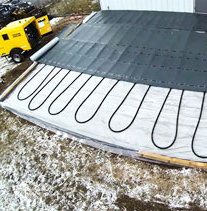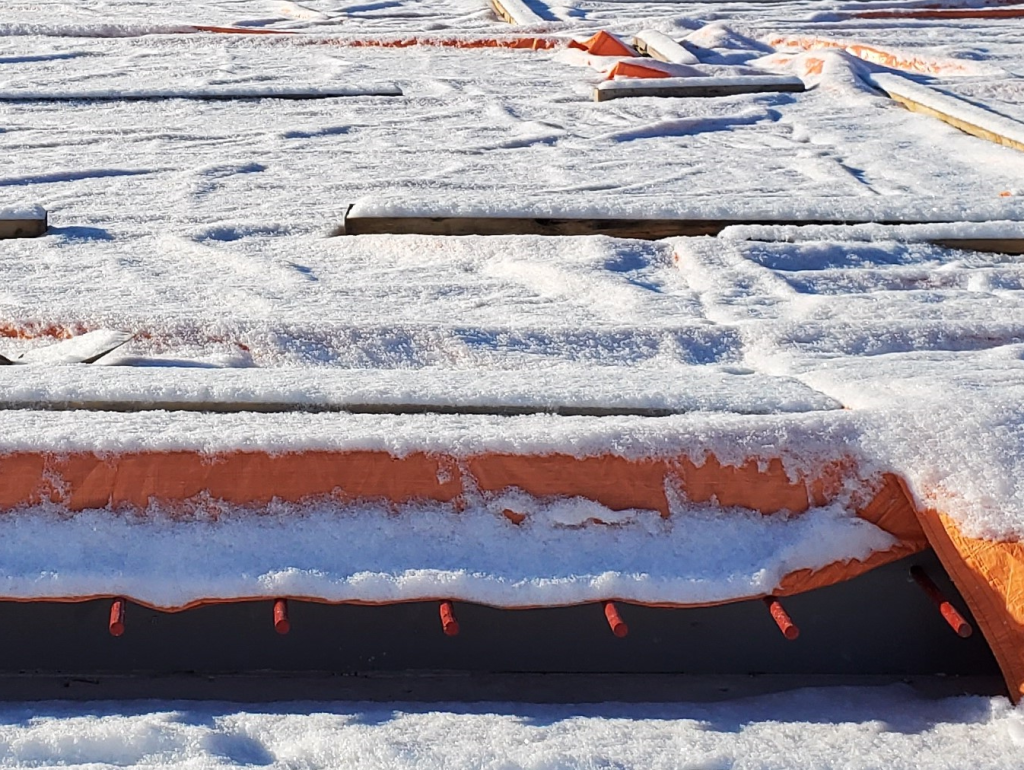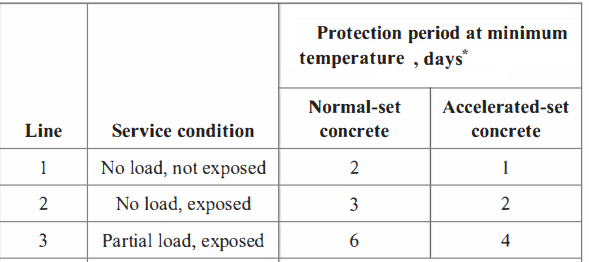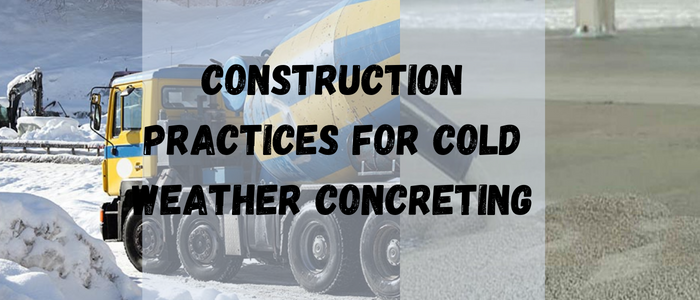Cold Weather Concreting
Construction Practices for Cold Weather Concreting
Casting, placing and finishing concrete in cold weather is called “cold weather concreting”
ACI 306 defines cold weather as “when the air temperature is expected to fall below 4℃ during the protection period of concrete for more than three successive days”
This means that if temperature is above 10℃ for more than half of any day, the period shall no longer considered as cold weather
Construction Practices for Cold Weather Concreting
This section provides guidance and strategies for cold concreting that help us to save your concrete from the issues related to cold weather concreting.
Materials
There are not specific constraints that are stated by codes for use in cold weather concreting. However, there are some conditions that used materials need to satisfy for example:
- The Canadian code requires a target compressive strength of concrete within a specific period of time and also sets a maximum water-to-cementitious material ratio based on the level and category of exposure.
- American code gives recommendations with using high-early strength cement (Type III), using high cement content and accelerators to speed up concrete hardening and achieve the compressive strength needed to resist freezing and thawing cycles within a suitable time period.
- Mixtures with low water-to-cementitious material ratio are also recommended to reduce the amount of water available for bleeding.
- Cold weather admixture systems (CWAS), antifreeze and/accelerating admixtures, can mitigate the effect of low temperatures on concrete placement and strength development by depressing the freezing point of mixing water.
Practices for Mixing and Transporting Concrete in Cold Weather
Preparing site before casting
- Plan the site and what you are going to do before the winter starts.
- Set up the needed enclosures and heating systems before the start of casting process.
- Make sure that surfaces, bases and subgrades that will contact concrete are free from snow and ice.
- Maintain the temperature of any surface in contact with concrete at 0℃ to the temperature of the placed concrete to avoid inconsistent setting, plastic shrinkage cracking and rapid moisture loss.
- Heat surfaces to at least 1.7℃ if outside air temperature is below -12℃.
- The differential temperature between concrete and soil-on-ground is recommended to be less than 11℃.
Mixing
For concrete elements with a thickness between 300-1800 mm that are being cast in sub-zero temperatures, ACI 306R requires minimum concrete temperature as mixed ranges from 7 – 21°C, while the maximum temperature ranges from 16-30°C. This can be achieved by the following:
- Heating the mixing water and aggregates to 60 and 40℃. Do not heat components excessively above 80 and 65℃ since this may cause flash setting of concrete.
- Keep in mind the loss in temperature of concrete during the transporting and handling times and consider that to get the initial required temperature of concrete that allows you to reach the desired concrete temperature at casting. Check ACI 306R for more on this.
- Do not use calcium chloride as de-icing salt on surfaces to avoid corrosion and chloride attack.
Placement
Codes specify a certain range for placement temperatures that should be followed to reach the required internal temperature of freshly mixed concrete. The placement temperatures vary depending on the size of the element.
For example, ACI 306 requires placement temperature between 13-24℃ for 300 mm thick elements. The purpose of the maximum limit is to avoid high rates of heat loss, due to larger differential temperature between concrete and air temperature, significant reduction in setting times, increased slump loss rate and excessive plastic shrinkage cracks.
Furthermore, more water content in concrete is required to alleviate the evaporation of mixing water in concrete when placed in high temperatures.
Curing and protection of concrete
The American and Canadian codes recommend heating procedure to maintain a temperature of at least 5 to 10°C to protect fresh concrete from freezing. To do this the following can be done for the heating:
- Set up temporary heated enclosures surrounding the location of casting to keep the temperature of air at normal temperature (10 to 20℃) to make sure the hydration reaction continues.
- To prevent carbonation of the fresh concrete, indirect and hydronic heaters are advised to discharge the exhaust gases outside of the enclosure.
- You can also use an internal heating system for concrete through embedded heat transfer tubing systems.

- The use of insulation blankets/covers is also recommended. There are different grades of the insulation materials depending on the outside temperature, thickness of element, etc.

- The protection period of concrete should be at least 3 days. The protection period can be reduced to 2 days by using Type III cement, extra 60 kg/m3 of cement, or accelerating admixtures.

Extend the protection period to achieve the required strength growth if the concrete strength is essential for structural safety.
- Curing concrete for at least 7 days to prevent the moisture loss.
- When using heated enclosures, provide more moisture by misting or heating with steam.
- Thermal cracking in concrete should be avoided by allowing it to cool gradually.
- The time at which forms are removed depends mainly on concrete elements exposure and the target strength required for concrete.
Post-Curing
Pay attention to the concrete temperature gradient after the protection period which can lead to thermal stresses and cracking.
The differential temperature depends only on concrete element thickness, the length/thickness of the element to its height ratio.
For example, according to ACI documents, a 300 mm concrete element surface temperature drop should not exceed 28℃ after one day of the end of the protection period.
Additionally, according to ACI 306R, fresh concrete shouldn’t be subjected to a single or repeated freezing and thawing cycle until it has a compressive strength of at least 3.5 and 24.5 MPa, respectively.
These given values specify the amount of time that concrete must be protected from the elements throughout the winter to develop the necessary strength for the secure removal of forms. After two days of curing, the majority of properly proportioned concrete mixes may achieve 3.5 MPa, which serves as a benchmark for early-age cement hydration that is sufficient.
Prior to attaining 3.5 MPa strength, mixing water can freeze, which can affect concrete’s durability and cause improper development of hardened characteristics, which can expedite the deterioration of the concrete.
Construction Practices for Cold Weather Concreting
Read Also:
COLD WEATHER CONCRETING: DEFINITION, ISSUES, AND PRECAUTIONS
